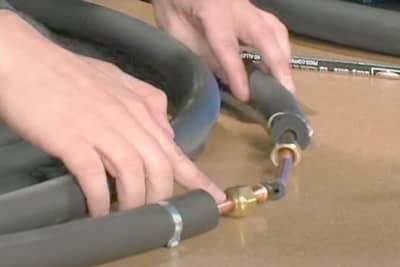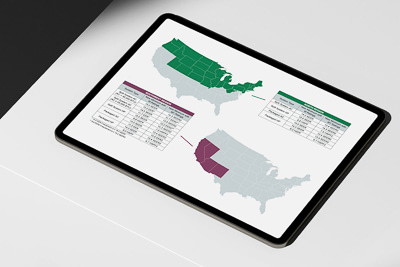Tip: Don’t Use or Buy More Cooling Capacity Than You Need
Overcooling your home can be expensive and waste energy. Don’t use or buy more cooling capacity than you actually need. Select an air conditioning unit with the lowest suitable capacity and highest efficiency. An oversized air conditioner can leave rooms cold and clammy because it does not run long enough to dehumidify the air. Oversized air conditioners also have a tendency to turn themselves on and off more frequently than properly sized units.
Tip: Keep the Equipment Clean
Ensure good air flow by keeping your condensing unit or heat pump free of debris. These pieces of equipment are located outdoors and require significant air flow to properly function. Clean the equipment at least once per year and regularly check to make sure leaves, grass and other debris are not creating blockage.
Tip: Change Your Air Filter Regularly
Changing your air filter regularly is a simple, inexpensive way to keep your air conditioning unit running at peak efficiency. The filter is located in your furnace, air handler or attached ducting. This filter helps keep dust and other debris from sticking to the blower and air conditioning coils inside your home’s heat pump, air conditioner or furnace. A dirty filter can block the flow of air, increasing operating costs and damaging the equipment. Change your filter as often as recommended by the manufacturer.
Tip: Have the Indoor Coil Cleaned
The evaporator coil is located on the top or side of your furnace, and if you have an air handler, it is located inside the air handler. Air flows across the coil to be cooled during the summer. When the air conditioning is on, water collects on the coil. The moisture on the coil can attract dirt, mold and other contaminants. A dirty indoor coil can be unhealthy, wastes energy and cuts the capacity of the cooling equipment. The coil should be cleaned every two to three years. It is sometimes necessary to cut into the ductwork to reach the coil, so it is advisable to hire a contractor to perform this maintenance for you.
Tip: Properly Match Your Condensing Unit/Heat Pump to Your Evaporator Coil
Your air-conditioning or heat pump system consists of two main parts: an indoor evaporator coil and an outdoor condensing unit/heat pump. These two parts are specifically designed to work together as a coordinated “team” to provide top performance and maximum efficiency and comfort.
If you install a new high-efficiency condensing unit, but don’t include a new, equally efficient and properly matched evaporator coil, you could end up with an inefficient or dysfunctional system. Check with a heating and air conditioning professional or call our technical support line at (800) 865-5931 to determine if your evaporator coil is properly matched to your condensing unit/heat pump.
Tip: Shade the Outside Condensing Unit or Heat Pump
Condensers and heat pumps that sit in a shady area use up to ten percent less electricity than those in direct sunlight.
Tip: Install a Programmable thermostats
Programmable thermostats are recommended to help keep your energy bills low. You can program these thermostats to automatically change temperature settings at night or when you are not at home. Energy bills can be dramatically lowered by not running the air conditioner unnecessarily.
Tip: Set Your Thermostat at 78 Degrees During the Summer
Keep your energy bills low by setting your thermostat no lower than 78 degrees during the summer. You will still enjoy the comforts of air conditioning while not absorbing the high costs for energy consumption. For each degree below that economy setting, your energy bills will creep up by eight percent on average. That means, if you set the thermostat at 72 degrees, it’s costing 48 percent more to run!
Tip: Install Ceiling Fans to Help Circulate Cool Air in the Home
The thermostat reads the temperature in your home, but what about the wind chill factor? Running a fan will help stir up the air in your home and make it feel 10 degrees cooler. Ceiling fans work the best when they run in a counter-clockwise direction. This causes them to blow air downward.
Tip: Check Your Ductwork
Sealing ductwork can help reduce energy consumption by 10 to 30 percent. Have a contractor inspect your ductwork for leaks. Pay extra attention to the ductwork that runs through the attic, basement or other un-cooled spaces in your home. Make sure the ductwork in these areas is properly insulated.
Tip: Keep Your Doors and Windows Shut and Well Sealed
Do-it-yourself weather stripping for doors and caulking for windows is cheap and easy to install. It pays to keep your house from leaking out cold air.
Tip: Don’t Open Your Windows When the AC is Off
When we think of air conditioning, we think primarily of cooling. But a major comfort benefit besides cooling that air conditioning provides is dehumidification – removing moisture from the air. When the air is nice and dry in the summer, we feel comfortable. When the air is too humid, we feel clammy and uncomfortable. Removing moisture from the home’s air then is a major function of air conditioning.
Understanding how your air conditioner does this will help you to operate it for maximum efficiency and comfort. When you first decide to turn on your air conditioning and it is hot and humid, and the home’s windows are open, there is a lot of moisture (water) in the air. When you close the windows and turn on the central air conditioning, the air conditioner will use about ½ of its energy initially to remove that moisture from the air while it cools. Because there is so much water in the air to remove at the start, the air conditioner will take longer to cool the house down, with only half of its energy going towards cooling.
However, after the air conditioner runs for a few hours, the majority of the moisture will be removed. At this point, the air conditioner can cool much more quickly, as well as run for shorter times to maintain that cool temperature.
For best use then, keep your windows closed in between air conditioning usage if you think you will need to use the air conditioning again soon. For example, if at the end of the day you were thinking of opening the windows for the night, but will need to turn on the air conditioning again in the morning, you might want to keep the windows closed and the AC on at night, too. Keeping the home closed once it has been dehumidified will mean the air conditioning can use most of its energy to cool the home, which will make it work faster as well as save money on electrical usage.


